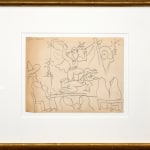



Jean Charlot
Mystery Play series, 1926
drawing
17 x 19 in
43.2 x 48.3 cm
43.2 x 48.3 cm
Further images
Jean Charlot, born in Paris to a Russian mother and an extended Mexican family, the artist was inspired by the fruitful community that the Mexican Renaissance fostered. In working alongside...
Jean Charlot, born in Paris to a Russian mother and an extended Mexican family, the artist was inspired by the fruitful community that the Mexican Renaissance fostered. In working alongside fellow Mexican art pioneers such as Diego Rivera, Pablo O’Higgins, and José Clemente Orozco, Charlot was able to develop his craft of muralism, painting and drawing.
Charlot was also a devout Catholic, and his Mystery Play series drew inspiration from biblical imagery and stories, featuring scenes that referenced Heaven, Hell, and guiding angels, all in the presence of a captivated audience of villagers.
Charlot was also a devout Catholic, and his Mystery Play series drew inspiration from biblical imagery and stories, featuring scenes that referenced Heaven, Hell, and guiding angels, all in the presence of a captivated audience of villagers.




